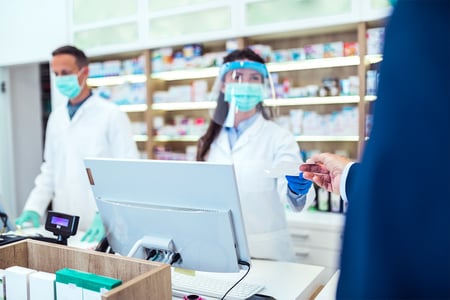
Responding to an environmental crisis in your pharmacy. What you should do first (second, and third)
 Maintaining sterility in an ISO certified compounding facility is simple when standard operational procedures and protocols are followed. Minimizing the chance of an environmental crisis requires implementing steps to mitigate contamination including utilizing proper disinfectants, monitoring pressure gauges, monitoring for particulates, room temperature, and airflow.
Maintaining sterility in an ISO certified compounding facility is simple when standard operational procedures and protocols are followed. Minimizing the chance of an environmental crisis requires implementing steps to mitigate contamination including utilizing proper disinfectants, monitoring pressure gauges, monitoring for particulates, room temperature, and airflow.
Neglecting sterility has a range of consequences, the most serious of which is criminal. This 2018 FDA release outlines how serious performing sterile compounding in a non-sterile room can be for staff and customers. Less severe microbial or particulate contamination may result in product disposal and recall, lost time and profits and pharmacy reputation.
Written to help quantify and manage airborne particles contamination worldwide, The International Organization for Standardization (ISO) has published two cleanroom standards, ISO 14644 Cleanrooms and associated controlled environments and ISO 14698 Cleanrooms and associated controlled environments – Biocontamination control. ISO 14644 specifies the classification of air cleanliness for concentration of airborne particles in cleanrooms and clean zones. ISO 14698 establishes a methodology for assessing and controlling biocontamination when cleanroom technology is applied.
Sources of contamination
According to a recent cleanroom maintenance study, a major source of pharmacy contamination is induced by humans. Employees may introduce contaminants to clean rooms from their hair or skin, or by wearing non-sterile garments that do not meet particulate requirements referenced in ISO 9073 Part 10. Before products are brought into the anti-room prior to entering the clean room, they should be removed from their outer box packaging and the inner bags should be wiped clean with 70% isopropyl alcohol. Verify that each item has the correct packaging and inspect for damage. If appropriate look for Gamma Radiation sterilization and Ethylene Oxide indicators.

Other causes of contamination include poor filtration, incorrectly calibrated or non-working monitoring equipment, product shortages, and power outages. An employee mistake, such as spraying an air filter with disinfectant, could cause the filer to lose effectiveness leading to clean room contamination.
Responding to an environmental crisis
What if your pharmacy has been operating normally, without an incident for months and all protocols have been followed? Despite this, an environmental crisis, trigged by an excursion occurs. How should you respond?
- Secure any drugs in the hood until staff can determine the cause of the excursion. In the case of microbial contamination recall the compounded batch of drugs/product. With a microbial excursion, there will be at least a 48-hour delay before detection and notification as the testing plates must undergo incubation for analysis and review.
- Identify the contamination trigger. Though each pharmacy is different, it is not likely an alarm will sound. It is more likely that staff will have noticed a decrease in cleanroom pressure, or a particulate increase from the particle counter or by reviewing the particulate log. In some cases, particulates are found while performing a final product inspection before quality releases the batch. If particulate levels are high before entering the cleanroom, do not compound until the cause is known. Performing daily surface and air testing ensures any microbial and/or particulate contamination will be identified quickly.
Cleaning and disinfecting logs – if kept up to date - can be used to identify triggers. For example, if your pharmacy has had no excursions and has been maintaining sterility protocol and an excursion occurs, reviewing logs might reveal a missed cleaning or change in cleaning frequency. - After the trigger is identified, follow standard operating procedures (SOPs) for remediation of the cleanroom. This will always include a full breach clean. Before your pharmacy can resume compounding, environmental verification is required which includes time-based viable and non-viable testing and monitoring.
- Once clean rooms are restarted, ensure the normal SOPs are followed by employees to prevent another event. New products should not be brought into the clean room until it can be validated using manufacturer certificates of sterility, conformation and analysis provided by the supplier. Maintain certificate and datasheet records for all products and associated lot numbers your pharmacy has received in the event of a manufacturer recall. Using trusted suppliers known to store and ship packages at correct temperatures may also reduce contamination risk.
Following these steps ideally get your pharmacy operational quickly and efficiently following an environmental crisis. In the meantime, avoid an event by keeping cleanrooms up to date with disinfectant cleaning rotations, and maintain detailed cleaning and product logs.
About DiNovo
Since 2013, DiNovo Pharmacy & Packaging Provisions has been a leader in delivering cleanroom consumables, disinfectants, medical devices, and cold chain shipping solutions to the compounding and specialty pharmacy marketplace. As an educational resource, coupled with top global manufacturer partnerships, DiNovo is able to help pharmacies drive efficiency, manage costs, and enhance compliance to help guide you through a constantly changing pharmacy marketplace.
.png?width=500&height=153&name=DiNovo%20Full%20Logo%20-%20Both%20Tags%20(500x153).png)